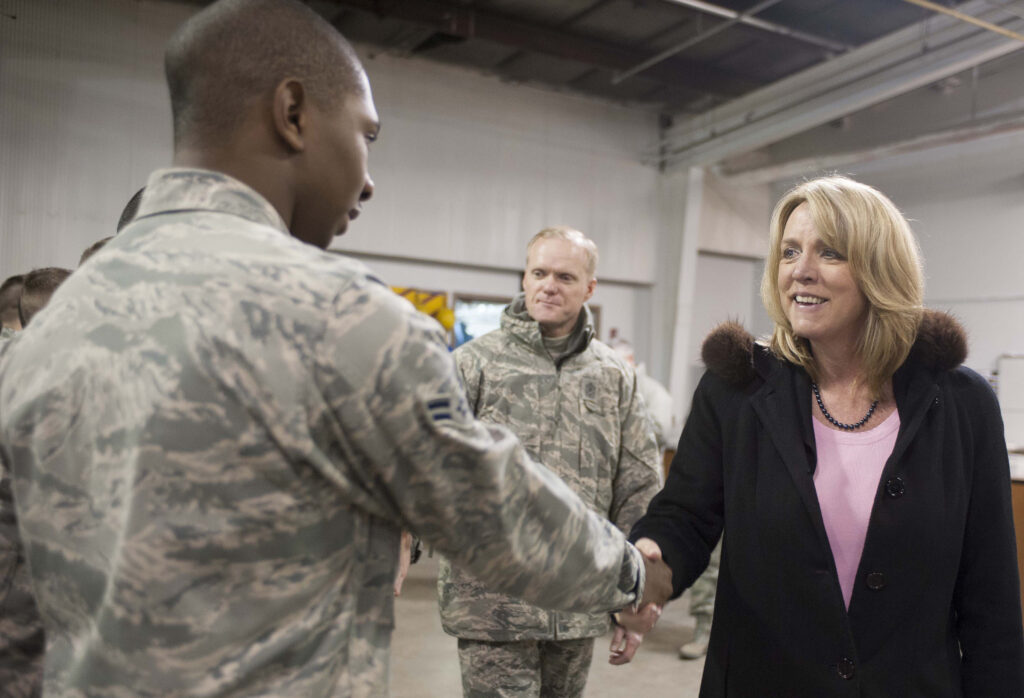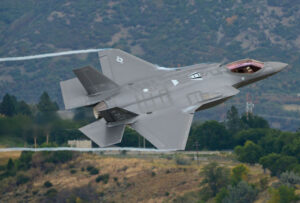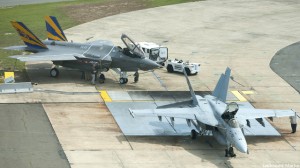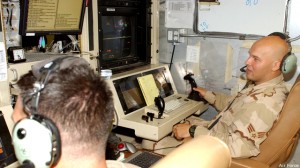2017 Forecast: Air Force Faces Intense Trump Scrutiny
Posted on

Air Force Secretary Deborah Lee James visits ICBM crews at Minot Air Force Base.
ARLINGTON: The Air Force got blasted from Donald Trump’s bully pulpit before the President-Elect was even inaugurated. It looks like 2017 — the youngest service’s 70th year — will be full of presidential turbulence.
[We rolled out our crystal balls for our 2017 forecast. Click to read the whole series.]
Outgoing Air Force Secretary Deborah Lee James put the best face on Trump’s intervention on Lockheed’s F-35 Joint Strike Fighter and Boeing’s Air Force One replacement, which moved swiftly from social media to private meetings with the CEOs of both contractors at Mar-A-Lago. But her concerns were clear.

F-35A
“What all of that really signals to me is that the President-Elect is going to be focusing on the taxpayer dollar, on efficiencies,” James told the Air Force Association this morning during her last public appearance as Secretary. “I think that’s an important focus. I tried to make it my focus for three years” — ever since her confirmation — and the service tries to inculcate a culture of cost-effectiveness in “even the brand new A1Cs [Airmen First Class] that come into the Air Force.”
That said, James continued, “it’s an unusual approach. It’s an approach that I’m not sure there’s another example of… doing a deep dive at this point into a program like this. But I think the signal is cost controls matter, efficiencies matter, and there will be times when perhaps a headline captures the attention of a senior policymaker.”
The F-35 program and cost is out of control. Billions of dollars can and will be saved on military (and other) purchases after January 20th.
— Donald J. Trump (@realDonaldTrump) December 12, 2016
James argued the Air Force has already made progress on both cost savings and program management. It cut headquarters costs 20 percent in a single year, for example, rather than the required five, and it’s stabilized several major programs, most notably Trump’s top target, the F-35.
“All additional cost controls and efficiencies are extremely appreciated, and you want all of that as well,” James said, “but as far as the capabilities of the F-35, you’ve heard me say, it’s performing magnificently, it’s a cut above anything the pilots have ever seen before, and we need it and we want it.”

A Navy F-35C and the plane it will replace, the F/A-18E Super Hornet, sit together on a runway.
What about the F/A-18E/F Super Hornet, the Navy fighter Trump told Boeing to “price out” as an alternative to the F-35? “It’s a fine aircraft. It’s a different aircraft. It does not fulfill the same requirements,” James said. “It’s a 4th generation, a very fine 4th generation fighter; the F-35 is an extremely fine 5th generation fighter.” Among many other differences, 4th gen planes lack stealth, which has to be built into the airframe and can’t be retrofitted.
To compare Super Hornet and F-35, James said, “it’s a little bit apples and oranges, and I have to believe that before any final decision would be made with respect to a major shift, the chief requirements officer would be consulted, and that would be the Chief of Staff of the Air Force.”
It’s not just Lockheed’s F-35 that’s doing better, James said. Boeing will deliver its first KC-46 fuel tanker later this year. The Air Force signed contracts in 2016 with Northrop Grumman for its B-21 Raider stealth bomber and with Sikorsky (now part of Lockheed) for its HH-60W Combat Rescue Helicopter. Requests For Proposals (RFPs) went out to industry for the JSTARS command plane replacement and T-X trainer just before New Year. The service is also moving ahead on nuclear recapitalization with the Ground-Based Strategic Deterrent (GBSD) ICBM and Long-Range Stand-Off (LRSO) cruise missile. Even the troubled OCX program to build new GPS ground stations, though “not out of the woods,” got Pentagon approval to proceed in October.

OCX concept image
Part of OCX’s resurrection was the software work of the Defense Digital Service, Defense Secretary Ashton Carter‘s project to bring civilian hackers and IT gurus into government for short tours to fix hard problems. James said she was so impressed she’s launching her own arm of the DDS, “a nerd cyber swat team,” officially the Air Force Digital Services Team. Software is increasingly the bane of federal procurement programs, including on OCX and, for that matter, the F-35 — although as F-35 is a joint program, the Air Force won’t try to impose its new nerds on the program managers.
What James didn’t say was that the Defense Digital Service and related initiatives like the Defense Innovation Unit (Experimental) and the Strategic Capabilities Office are very much personal priorities of outgoing Secretary Carter. Unlike multi-billion-dollar weapons programs, these pilot projects lack the institutional roots to survive if the next administration loses interest.
Other, more traditional personnel initiatives are likely to do well, however, since Trump wants to increase the size of all four services, as did the recently passed 2017 National Defense Authorization Act. James’ priorities for people, in order, are

Predator drone operators.
- First, more drone pilots, including a new “Remotely Piloted Aircraft” unit to be stood up shortly to relieve pressure on existing overworked drone squadrons;
- more maintainers for the service’s aging aircraft, such as the B-52 whose engine recently fell out in mid-flight (the investigation is ongoing, James said);
- more cyber specialists — including 3,000 more in the Air National Guard;
- and finally nuclear weapons personnel. James in fact just came from visiting ICBM crews at snow-bound Minot Air Force Base in North Dakota, and Trump has Twittered his support for a major nuclear buildup.
For all the cutting edge technology the Air Force uses, James said, it’s the people who make that tech actually work that have been and should remain the “very top focus.”
Subscribe to our newsletter
Promotions, new products and sales. Directly to your inbox.
